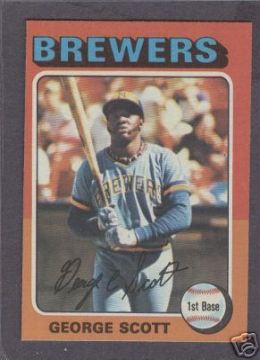George Scott 1975 Topps Company (No. 360)
When an inquiring reporter asked George "Boomer" Scott to identify the material used to make the distinctive necklace he wore on the playing field, the hulking first baseman responded dryly: "Second basemen’s teeth." It is still one of the best answers a ballplayer has ever given to a beat writer or newspaper columnist. In reality, the unusual necklace (which was in evidence on his 1975 Topps card) was made up of shells, wooded beads and possibly ivory tusks of some sort, but the reality doesn’t come close to matching the color of Scott’s sinister imagination. Whatever the composition of the necklace, the jewelry made the feared slugger that much more intimidating when he strolled to the plate.
Scott had other interesting accessories to his sense of baseball fashion. Unlike most fielders, he wore a helmet while playing first base. Scott began wearing the helmet in the field because of some idiotic fans on the road, who had decided to throw hardened objects his way. Given their unruly behavior toward the usually amiable Scott, Boomer might have been tempted to construct another necklace—this one consisting of fans’ teeth. But Scott was never that way; he usually treated the fans better than they did him.
While the helmet and the necklace were always evident during the games, Scott exhibited another wardrobe preference as part of his pre-game workouts. During his second stint with the Red Sox, Scott used to wear a rubberized suit in a futile attempt to lose some of the excess weight that always seemed to accumulate toward his midsection. (The tight-fitting polyester uniforms that came into use in the 1970s didn’t accentuate Boomer’s figure either.) As former Sox manager Don Zimmer pointed out in his first book with Bill Madden, Scott might have sweated off a few pounds during each early evening workout, but he seemed to have gained all the weight back by the time the first pitch rolled around.
Scott’s weight, fashion sense, and jovial sense of humor overshadowed his ample abilities as a hitter. A key member of the 1967 "Impossible Dream," Scott remained a mostly productive player with the Red Sox through 1971 before being traded to the Brewers in a seven-player blockbuster deal that also involved Cecil Cooper and Tommy Harper. As a member of the Brewers, Scott twice reached the 100-RBI milestone and shared an American League home run title in 1975 before returning to Boston via another trade during the winter of 1976.
Slowed by injuries, Scott began to decline in 1978, was released twice the following summer (by both the Red Sox and the Royals), and actually finished up his career with the Yankees toward the tail end of 1979. I distinctly remember Scott’s appearance in Yankee pinstripes as one of the few positive memories of an otherwise dismal and tragic season; The Boomer batted .318 and slugged .500 in 44 late-season at-bats. Scott played so well that final month that I thought the Yankees would bring him back for 1980, but he became a victim of an off-season of rebuilding, which included the signing of another right-handed hitting first baseman-DH, Bob "The Bull" Watson.
Convinced that he could still hit, Scott resumed his career in the Mexican League while awaiting a major league call that never came. After his playing days, he became a manager, first in the Mexican League and then most notably with an independent league team called the Massachusetts Mad Dog. Filled with free spirits and wild personalities, the team reflected Scott’s loose and freewheeling managerial style. In 1996, the Mad Dogs won the North Atlantic League championship under Scott’s scattershot direction.
Scott is fully retired from baseball today and battling some health problems caused by his continuing weight gain, which now has him well over the 300-pound plateau. According to an upcoming biography on Scott, the former slugger is determined to lose some of the excess weight and improve his physical conditioning. If he achieves those goals, a return to managing or coaching remains a possibility.
And that would be quite appropriate for a sport that needs all the colorful characters it can find.
Bruce Markusen is the author of eight books, including The Team That Changed Baseball, and the writer of Cooperstown Confidential at MLB.com. He will also be broadcasting Monday’s Hall of Fame Game between the Orioles and Blue Jays, joining former Yankee Billy Sample in the booth, for MLB Radio (MLB.com).



